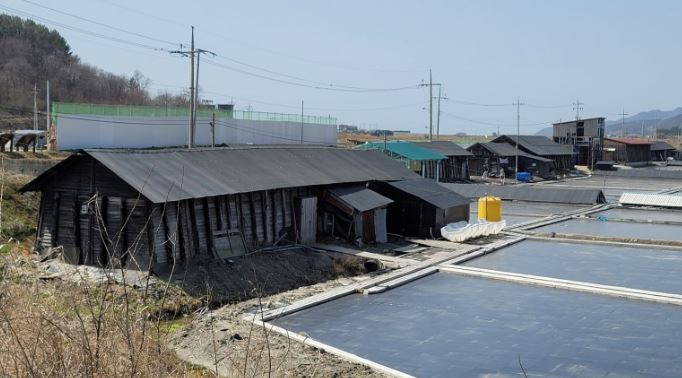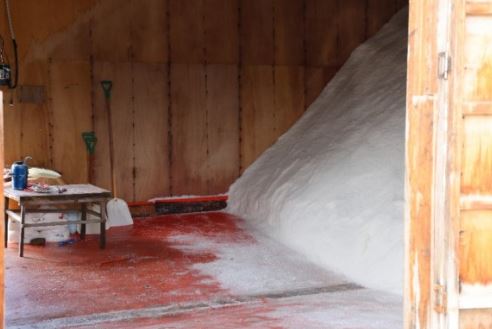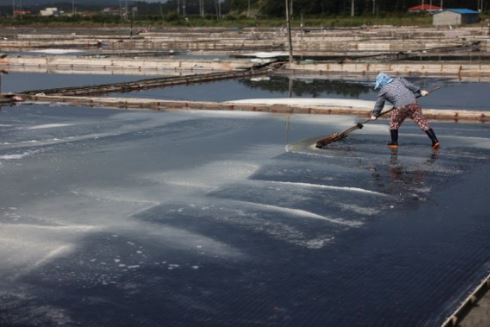korea salt story
korea salt story

It is the season when sun-dried salt and "summer salt" will pour out.
If the weather is good in June, salt is of good quality that summer.
Salt collected in June builds up in a warehouse and comes on the market in July and August.
"I like salt feet" means that the thickness of salt is appropriate in summer.
Salt in the season when the weather is not hot has good feet.
I said, "Saragi salt." Salt from the midsummer salt farm is too thick.
It is not suitable for edible salt.
Salt made in the salt farm is good for the weather in June.
It is a good season for sea salt with good feet.
We have long been a 'salt-deficient country'.
Salt is so common.
Why is there a shortage of salt? It hasn't been long since salt was common.
Until half a century ago, salt was a national resale.
Resale is a system in which the state manages production, distribution, and consumption.
It means "state monopoly."
It was precious, so I used it as a resale.
Unbelievable, the private salt trade was illegal.
Some people ask back, "Isn't it about the Joseon Dynasty?"
The same was true of Japanese colonial era, and for some time after liberation,
salt was the state's resale.
This is the content of an article on page 2 of the Dong-A Ilbo dated March 13, 1962.
The title is "Don't buy the merchant salt."
Don't buy the merchant salt. - Request for resale office.
On the 12th, the resale office asked consumers across the country not to buy salt
from merchants other than salt distributed by the 指定賣((( (salt-designated retail office).
The amount of salt in retail stores nationwide amounts to 1.18 million bags.
Salt fields will be privatized from May this year, and until then, there can be no private salt.

I slept on March 13, 1962. In May, just two months later, the salt farm will be privatized.
Until then, it is a "salt state resale." Private salt distribution is illegal.
It means to keep this. Salt is sold only at the nation's "salt-designated retail stores."
The amount is also 1.18 million bags, which is plenty.
There is no need to buy illegal salt. Private salt trading is illegal.
Before privatization, it is an article that tells you to follow a legitimate "purchase" system.
Japanese colonial era, not only after liberation,
but also during the Joseon Dynasty, salt shortages remained.
No matter how much the government manages salt, there is no way to solve the salt shortage.
If production fails to comply with consumption, it is insufficient. Salt was scarce,
and the price was ridiculously high. As a state, there were no sharp measures.
Salt is deeply related to taxes as well as salaries.
The state and government offices directly produce salt, sell it to the private sector, and make profits.
The same is true even if the private sector produces salt.
It collects taxes on production, distribution, and sales.
The tax on salt is the tax on salt. Either side produces huge profits.
This is why the state regarded salt as a major tax-paying tool.
If it's expensive, you don't have to buy it.
Salt is a necessity.
There's no way not to use it.
"The Annals of the Joseon Dynasty" is an article in November in the 9th year of King Taejong's reign (1409).
Lowering the battery, the audience planned the profit of baking salt to enrich the country, and Yuan,
the Tang Dynasty, traded it to the people with the benefit of salt and doubled the profit rather than recommending farming,
so if so, the benefit of salt is very important.
Now that the state has installed a salt minister and baked salt to trade, it is the old law.
However, since the thing called Po cannot be eaten by hungry people,
please trade both Seoul and the outer Gwanyeom with rice to supplement the military.

Gwangwan (725 BC~645 BC) was a politician of the Qi Dynasty during the Spring and Autumn National Period.
It is a person who is more than 2,500 years old.
One of the things that made the Qi Dynasty rich was grilled salt and traded with the private sector.
The same goes for Yuan of the Tang Dynasty.
Salt production makes twice as much profit as farming.
The 9th year of King Taejong was less than 20 years after the reign of the Joseon Dynasty.
While laying the foundation for the country, he talks about finances and explains the importance of grilling salt.
Even though you can't eat the cloth and cloth, some even say that you should get rice with salt and use it as military rice.
Gwanyeom in the above article is a salt managed by the state and government offices.
The use of the word Gwanyeom means that there was already a private "sayeom."
Salt was always insufficient, and on the one hand, it was important.
Records of the Joseon Dynasty show the expression "grilling salt."
Yes. Salt was not made by drying and boiling it in a salt farm. Salt was baking.
Until 1907, when the salt field was first built, the salt on the Korean Peninsula was "Jayeom," a baking salt.
The word "ja" of the salt means to bake, cook, boil, and boil.
Increase salinity by scooping seawater.
Pour salt water with increased salinity into a large cauldron and fire firewood.
The seawater in the pot drowsens and forms a salt crystal.
This salt is the salt.
If we have to find "traditional salt," it is our tradition to have salt.
Throughout the Goryeo and Joseon periods, the Korean Peninsula ate salt.
There is no accurate record, but even before that, salt on the Korean Peninsula would have been salt.
In 1907, a salt farm that produces sea salt was built in Juan, Incheon.
Already, the Japanese colonial rule actually ruled the Korean Peninsula.
The introduction of the Japanese brought in a popular method in Taiwan and other countries.
Prior to that, all of them were self-salt.
In 1907, the history of sea salt making salt in salt fields began.
This salt field dyeing method starts in Juan, Incheon,
passes through Anmyeondo Island on the west coast of Chungcheong Province, and the coast of Jeonbuk,
and extends to the Sinan area, today's famous sea salt producing area. It is the history of sea salt in Korea.

To make the salt, a cauldron, firewood, seawater, and manpower to make the salt are needed.
There are also cast iron cauldrons, but cauldrons made of red clay were also common because iron was precious.
The red clay cauldron was not adopted because it was good.
Although the ability to make salt is poor, iron is precious, so a cauldron was made of red clay.
If you install a salt production tool on the beach, seawater is common.
The problem is the manpower that brings seawater.
We need to move heavy seawater and get firewood.
You have to touch hot firewood all year round and move it when salt is produced.
Salt, seawater, and firewood are all heavy.
No one jumps into the work of making shish salt.
There was one good thing.
It was possible to produce salt in all areas of the Korean Peninsula where seawater could be obtained.
From the coast of Hamgyeongdo Island on the east coast to the south coast and around the large cities on the west coast,
there were all facilities for producing salt.
Still, salt was always scarce and precious.
Sea water is common, but there was a lack of manpower to make cauldrons, firewood, and salt.
Salt is largely divided into government salt and private salt.
Involvement is a salt managed by the state.
The state mobilizes manpower to make and manage salt.
Contamination belongs to individuals. Central or local forces and rich people have their own salt production facilities.
Prepare pots, wood, and manpower to produce salt.
Salt production and sales and subsequent tax issues have always remained a major national concern.
Throughout the Joseon Dynasty, there were debates over salt production, distribution,
sales, and taxes, but they were not easily resolved.

This is the record of the Annals of the Joseon Dynasty in April in the 6th year of King Taejo (1397), the early Joseon Dynasty.
The title is "The executive officer proposes 10 articles of poetry and lyric renewal,
including the ban on the installation of the stupa of the nobleman."
Among them, salt management is a key issue.
(Strategy) The most painful thing for the soldiers and the people of each angle is to ride a boat,
but now the history of supplying it to the military food is very hard and there are some people
who run away and hide when it's time to work early, but from now on, the profits of fish salt are surplus.
The soldiers on the boat are asked to fish and grill salt. It's against the rules.
Those who do hard work say, "Let's grill salt, catch fish, and supplement them with food."
In the end, they pay for the military's meals with the profits from fish salt.
Work is hard and there is not enough style.
There's no way. Avoid conscription.
If you grill salt and fish separately, all the profits should be paid separately to the soldiers as surplus.
Avoiding salt roasting, soldiers, monks, and lower class people were forced to grill salt.
In the early Joseon Dynasty, such "improvement measures" were already made, but salt production,
sales, taxes, and profit distribution were not easily fixed.
Nongam Yoo Soo-won (1694-1755), a practical scholar in the late Joseon Dynasty,
left a "Wuseo," a "National Management Guideline."
In "Wuseo", salt-related policies and taxes are also shown in detail.
Nongam served as a government official during the reign of King Yeongjo.
Unfortunately, the suggestion of Nongam was not accepted.
Nongam was caught up in reverse hair in his later years.
His national management policy was also not accepted at all.
It is part of Nongam's "Wuseo."
(Strategy) There must be a law in salt-related matters.
Taxes can only be collected after the law exists.
To grade George's land and open a gold spirit in Chojang, to give Yeomjeong a shelter,
and to Yeomsang a situation.

Unfortunately, even in the days of Nongam, there was no exact legal system for salt.
Yeomjeong is a person engaged in the production of salt and is also called Yeomhan.
Nongam Yusuwon's argument is simple.
The plan calls for the state to properly pay Yeomjeong and manage all of them,
including salt production, distribution, and sales.
The reason is simple. Tax and salt production and sales profits are of great help to the national treasury.
With the production of sea salt in Juan in 1907, salt on the Korean Peninsula changed from salt to sea salt.
Salt is still confusing. Although it is not a salt shortage, cheap salt is imported,
and people are still confused between refined salt and sea salt.
